
TRACE ELEMENTS AND ELECTROLYTES
Scope & Guideline
Pioneering Discoveries in Electrolyte Science
Introduction
Aims and Scopes
- Trace Element Biochemistry:
The journal publishes research exploring the biochemical roles of trace elements like magnesium, selenium, and zinc, examining their influence on metabolic pathways and health outcomes. - Electrolyte Homeostasis:
It focuses on the regulation and balance of electrolytes in biological systems, investigating how imbalances affect health, particularly in conditions like hypertension, diabetes, and metabolic syndrome. - Nutritional Studies:
Research is conducted on the nutritional adequacy of various diets and food products in relation to trace elements and electrolytes, assessing their impact on health and disease. - Clinical Studies and Trials:
The journal features clinical research, including trials on supplementation and dietary interventions aimed at correcting deficiencies or imbalances of trace elements and electrolytes. - Pathophysiology and Disease Associations:
It investigates the associations between trace elements, electrolytes, and various diseases, providing insights into how these elements may contribute to disease mechanisms and progression. - Public Health and Epidemiology:
The journal addresses public health issues related to trace elements and electrolytes, including population studies and the implications of deficiencies or excesses on community health.
Trending and Emerging
- Impact of COVID-19 on Trace Element Levels:
There is a notable increase in studies examining how COVID-19 affects trace element levels and electrolyte balance, highlighting the pandemic's influence on health and nutrition. - Role of Magnesium in Metabolic Health:
Research focused on magnesium's role in metabolic disorders, particularly its effects on glucose metabolism and diabetes management, has gained prominence, reflecting a growing recognition of its importance in health. - Trace Elements in Mental Health:
Emerging themes include the investigation of trace elements like magnesium and their potential roles in mental health and mood disorders, suggesting a new frontier in understanding how nutrition impacts psychological well-being. - Nutritional Interventions for Chronic Diseases:
There is an increasing trend towards exploring dietary interventions and supplementation strategies aimed at preventing or managing chronic diseases through optimizing trace element intake. - Epidemiological Studies on Trace Elements:
An upsurge in epidemiological studies assessing trace element status in various populations is evident, emphasizing the need for public health strategies to address deficiencies and imbalances.
Declining or Waning
- Heavy Metals and Toxicology:
Research on heavy metals and their toxic effects has been less prominent in recent publications, indicating a potential shift towards more nutritional and therapeutic aspects of trace elements. - Historical Perspectives on Trace Element Exposure:
Studies focusing on historical cases of trace element exposure, such as ancient poisoning incidents, seem to be declining, suggesting a move towards contemporary issues in trace element research. - Basic Mechanistic Studies:
There appears to be a waning interest in purely mechanistic studies of trace elements without clinical or nutritional context, as the journal increasingly emphasizes applied research and clinical relevance.
Similar Journals

Journal of the American Nutrition Association
Championing Open Access to Nutrition ResearchJournal of the American Nutrition Association is a premier scholarly outlet dedicated to advancing the field of nutrition science. Published by ROUTLEDGE JOURNALS, TAYLOR & FRANCIS LTD, this journal aims to disseminate high-quality research that addresses the complexities of diet, health, and nutrition in various populations. With a robust impact factor demonstrating its significance in the realm of Medicine and Nutrition, it holds notable ranks in both the Medicine (miscellaneous) and Nutrition and Dietetics categories within Scopus. The journal supports a vision of expanding access to vital nutrition research through its open-access options, enhancing the visibility and impact of published works. As it continues to evolve from 2022 to 2024, the Journal of the American Nutrition Association stands as an invaluable resource for researchers, health professionals, and students keen on contributing to and staying informed about the latest advancements in nutrition science.

Nature Metabolism
Connecting metabolic mechanisms to real-world health outcomes.Nature Metabolism, published by NATURE PORTFOLIO, is a leading journal dedicated to advancing the field of metabolic research and its implications across various biological systems. Since its inception in 2019, this esteemed journal has rapidly established itself as a vital resource for researchers, professionals, and students alike, reflecting its prominence through a prestigious Q1 ranking in several key categories including Cell Biology, Endocrinology, Diabetes and Metabolism, Internal Medicine, and Physiology. With an impressive Scopus ranking, underscoring its impact in Medicine and Biochemistry disciplines, Nature Metabolism offers an exceptional platform for disseminating high-quality research that explores the intricate mechanisms of metabolism and its association with health and disease. Although currently not open access, it continues to gain visibility and appreciation within the scientific community, ensuring that groundbreaking findings reach interested audiences globally from its hub in Berlin, Germany. Whether you are an experienced researcher or an aspiring student, Nature Metabolism serves as an invaluable asset in navigating the complexities of metabolic science.

JOURNAL OF NUTRITIONAL SCIENCE AND VITAMINOLOGY
Exploring the Science Behind Nutritional HealthJOURNAL OF NUTRITIONAL SCIENCE AND VITAMINOLOGY, published by the CENTER ACADEMIC PUBL JAPAN, serves as a vital platform for scientific inquiry into the fields of nutrition and vitaminology. Established in 1973, this peer-reviewed journal not only focuses on the biochemical aspects of nutrition but also addresses broader implications on health and disease prevention. With an ISSN of 0301-4800 and an E-ISSN of 1881-7742, it provides researchers, health professionals, and students access to novel studies and reviews that advance understanding in nutritional science. Though currently not an open access journal, it maintains a respectable position in academia, with a 2023 Quartile Q3 ranking in both Medicine (miscellaneous) and Nutrition and Dietetics, and Scopus rankings reflecting its growing influence. As the journal converges towards 2024, it remains committed to enlightening its audience on the latest research developments and fostering discourse within this essential scientific community.
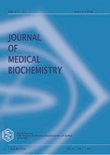
Journal of Medical Biochemistry
Unveiling the Biochemical Secrets to Better HealthJournal of Medical Biochemistry is a distinguished peer-reviewed journal published by the SOC MEDICAL BIOCHEMISTS SERBIA, focusing on the significant intersection of biochemistry and medicine. With an e-ISSN of 1452-8266, this Open Access journal has been enriching the academic community since 2007, providing vital insights and research findings that advance the field of medical biochemistry. Based in Belgrade, Serbia, the journal plays a pivotal role in disseminating contemporary research, highlighted by its impressive standings in the 2023 quartile rankings, featuring Q2 in Medical Biochemistry and Q3 in Clinical Biochemistry. The journal is recognized in Scopus with rankings that position it within the discerning area of medical biochemistry and clinical biochemistry, attesting to its influence and relevance. By promoting innovative research and facilitating an open exchange of scientific ideas, the Journal of Medical Biochemistry is a crucial resource for researchers, professionals, and students dedicated to uncovering the biochemical underpinnings essential to improving human health.
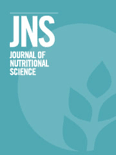
Journal of Nutritional Science
Innovating dietary research for impactful health solutions.The Journal of Nutritional Science, published by Cambridge University Press, is a leading open-access journal dedicated to the field of nutrition and dietary research. Established in 2012, this journal aims to disseminate high-quality research on nutrition, dietetics, and their implications for health and disease. With an impact factor reflective of its growing importance—holding Q2 and Q3 rankings in relevant categories such as Nutrition and Dietetics and Endocrinology—the journal serves as a vital platform for researchers, professionals, and students interested in evidence-based advancements within the nutritional sciences. The Journal of Nutritional Science is based in the United Kingdom and leverages a global network of experts to foster discussions that drive innovation in food science and health policies. By enabling open access to its content, it ensures that critical knowledge is readily available to the academic community and beyond, promoting a healthier, more informed society.
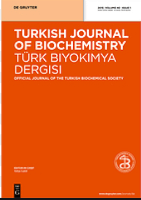
Turkish Journal of Biochemistry-Turk Biyokimya Dergisi
Illuminating the path of biochemistry with open access scholarship.Turkish Journal of Biochemistry-Turk Biyokimya Dergisi, published by WALTER DE GRUYTER GMBH, is a pivotal open-access journal in the field of biochemistry that serves as a forum for innovative research and scholarly discourse. Since its inception in 2009 and transitioning to open access in 2015, this journal has gained recognition within the scientific community, reflecting a commitment to advancing knowledge in biochemistry and related medical sciences. With a diverse scope that encompasses molecular biology, clinical biochemistry, and the broader arena of biochemical studies, Turkish Journal of Biochemistry offers researchers, professionals, and students access to impactful studies and current developments. Although currently positioned in the lower quartiles in specific categories, the journal aims to enhance its visibility and engagement as it converges towards a promising future, fostering collaboration and knowledge exchange among biochemists across Turkey and around the globe. This journal is vital for anyone seeking to stay abreast of emerging trends and research findings in biochemistry.

JOURNAL OF PHYSIOLOGY AND BIOCHEMISTRY
Pioneering Research in Physiology and BiochemistryJOURNAL OF PHYSIOLOGY AND BIOCHEMISTRY, published by Springer in the Netherlands, serves as a pivotal platform for disseminating high-quality research within the fields of physiology, biochemistry, and related biomedical sciences. With an impressive impact factor reflected in its categorization as Q2 in Biochemistry and Q1 in Medicine (miscellaneous), this journal fosters a vibrant community of scholars dedicated to advancing knowledge and innovation. The journal’s broad scope encompasses a wide range of topics from cellular mechanisms to systemic physiology, making it relevant for both theoretical and applied sciences. Researchers and practitioners are encouraged to utilize the available Open Access options to reach a wider audience. The journal’s continuous contribution to the scientific dialogue since its inception in 1996 positions it as a key resource for professionals and students alike, facilitating the exploration of cutting-edge topics and collaborative research opportunities.

EUROPEAN JOURNAL OF NUTRITION
Unleashing the Power of Nutrition ScienceEuropean Journal of Nutrition, published by Springer Heidelberg, is a premier outlet for groundbreaking research in the field of nutrition and dietetics. Established in 1996 and set to continue its impactful legacy until at least 2024, this journal enjoys an impressive recognition, holding a Q1 category rank in both Medicine (miscellaneous) and Nutrition and Dietetics, with notable Scopus rankings that place it in the top 10% of its field. The journal facilitates open access options, enhancing the dissemination of knowledge across the globe. It serves as a vital platform for researchers, healthcare professionals, and students, promoting the exchange of innovative ideas and advancements in nutritional science that aim to improve health outcomes worldwide. With a commitment to quality and relevance, the European Journal of Nutrition continues to shape the future of nutrition research and practice.
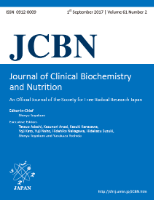
JOURNAL OF CLINICAL BIOCHEMISTRY AND NUTRITION
Transforming Research into Nutritional WisdomJOURNAL OF CLINICAL BIOCHEMISTRY AND NUTRITION is a premier publication dedicated to the advancements in the fields of clinical biochemistry, nutrition, and dietary sciences. Published by the esteemed JOURNAL CLINICAL BIOCHEMISTRY & NUTRITION in Japan, this journal serves as a crucial platform for researchers and professionals to disseminate their findings and insights. With an ISSN of 0912-0009 and an E-ISSN of 1880-5086, it features a broad spectrum of original research articles, reviews, and case studies, fostering a deeper understanding of the interplay between biochemical processes and nutritional science. Notably, the journal has achieved significant rankings, placed in the Q3 and Q2 quartiles across various relevant categories, indicating its rising impact and relevance within the scientific community. Researchers will benefit from its rich repository of knowledge, while students and professionals will find it an invaluable resource for staying updated with the latest developments. Access options are available for interested readers, further contributing to the journal's objective of promoting open dialogue and research in clinical biochemistry and nutrition.
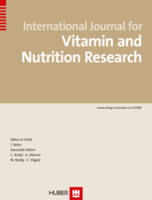
INTERNATIONAL JOURNAL FOR VITAMIN AND NUTRITION RESEARCH
Innovating research at the intersection of diet and health.INTERNATIONAL JOURNAL FOR VITAMIN AND NUTRITION RESEARCH, published by HOGREFE AG-HOGREFE AG SUISSE, stands as a pivotal resource in the intersecting realms of nutrition and health. With a rich publication history spanning from 1971 to 2024, this esteemed journal provides a platform for innovative research in the fields of Endocrinology, Diabetes and Metabolism, Medicine (miscellaneous), and Nutrition and Dietetics. The journal holds a respectable Q3 category ranking in these disciplines for 2023, attesting to its influence within the academic community. Although it does not offer open access, the ISSN 0300-9831 and E-ISSN 1664-2821 identifiers ensure its broad accessibility. Researchers, practitioners, and students alike benefit from its rigorous peer-reviewed content, which greatly contributes to the advancement of knowledge and best practices in nutrition research. The journal's commitment to excellence is further exemplified by its notable rankings in Scopus, where it achieves impressive standings across relevant categories. For anyone involved in the exploration of vitamins, nutrition, and their crucial roles in human health, this journal is an essential tool for staying informed and engaged with the latest scientific developments.